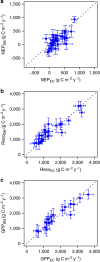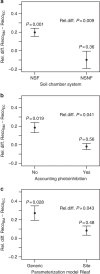Evaluating the convergence between eddy-covariance and biometric methods for assessing carbon budgets of forests
- PMID: 27966534
- PMCID: PMC5171944
- DOI: 10.1038/ncomms13717
Evaluating the convergence between eddy-covariance and biometric methods for assessing carbon budgets of forests
Abstract
The eddy-covariance (EC) micro-meteorological technique and the ecology-based biometric methods (BM) are the primary methodologies to quantify CO2 exchange between terrestrial ecosystems and the atmosphere (net ecosystem production, NEP) and its two components, ecosystem respiration and gross primary production. Here we show that EC and BM provide different estimates of NEP, but comparable ecosystem respiration and gross primary production for forest ecosystems globally. Discrepancies between methods are not related to environmental or stand variables, but are consistently more pronounced for boreal forests where carbon fluxes are smaller. BM estimates are prone to underestimation of net primary production and overestimation of leaf respiration. EC biases are not apparent across sites, suggesting the effectiveness of standard post-processing procedures. Our results increase confidence in EC, show in which conditions EC and BM estimates can be integrated, and which methodological aspects can improve the convergence between EC and BM.
Figures



References
-
- Baldocchi D. D. Assessing the eddy covariance technique for evaluating carbon dioxide exchange rates of ecosystems: past, present and future. Global Change Biol. 9, 479–492 (2003).
-
- Chapin F. S. III et al.. Reconciling carbon-cycle concepts, terminology, and methods. Ecosystems 9, 1041–1050 (2006).
-
- Baldocchi D. Measuring fluxes of trace gases and energy between ecosystems and the atmosphere-the state and future of the eddy covariance method. Global Change Biol. 20, 3600–3609 (2014). - PubMed
-
- Baldocchi D. et al.. FLUXNET: a new tool to study the temporal and spatial variability of ecosystem-scale carbon dioxide, water vapor, and energy flux densities. Bull. Am. Meteorol. Soc 82, 2415–2434 (2001).
-
- Aubinet M., Vesala T. & Papale D. Eddy Covariance: A Practical Guide to Measurement and Data Analysis Springer (2012).
Publication types
MeSH terms
Substances
Grants and funding
LinkOut - more resources
Full Text Sources
Other Literature Sources

